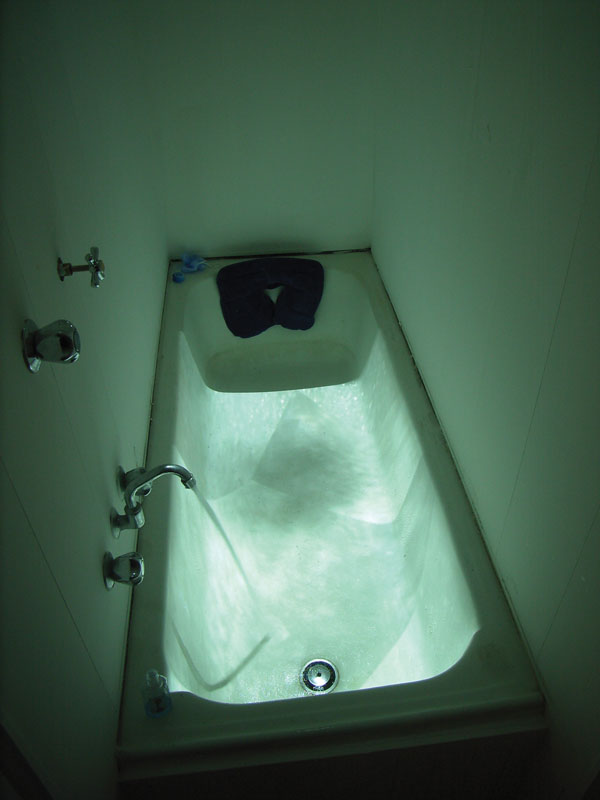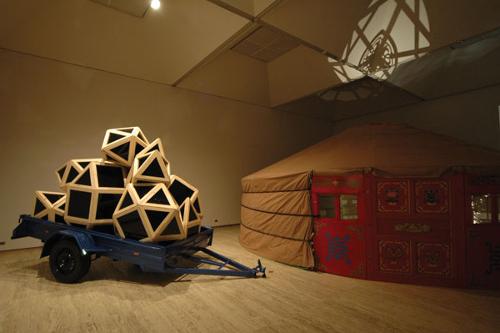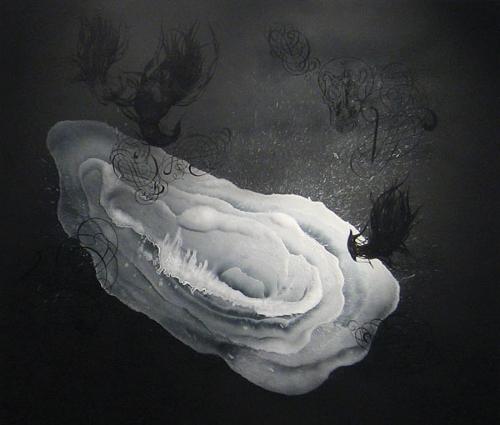
'"Why do birds suddenly appear, every time you are near? Just like me, they long to be, close to you...'"
Hearing this classic Carpenters track on the headphones supplied, I look inside a contraption branded with the derogatory comeback words 'you are'. With a slowly turning rotisserie strung with fibreboard steaks, over a pile of back-lit egg shells, the thin, veneer-ply box is intentionally ridiculous. Mish Meijers has created a machine - like a flat-pack, mail order thing - that you might stick in the corner of your lounge room for those times when you don't want to make sense of the world.
You are is one of six pieces in the first show for six a, a new Artist Run Initiative (ARI) space at 6a Newdegate Street behind the North Hobart strip, in a former slaughteryard complex. Appropriately titled No.1, the show is like a meaty tasting plate hinting at the flavour of future shows. Each of the contributors either works in the new space or is part of the ARI.
Just take a bath by Josie Hurst is a perfect entree. Taking advantage of an existing, quirky, bathing space - a shallow tub in a walk-through cubicle - Hurst has portrayed the place of consolation that the bath can be for the heartbroken. A projection from the mezzanine above throws imagery of moving water onto the partially filled tub with dimensions matching the imagined body and soft bubble patterns reflected on the ceiling. Hurst's video and accompanying story delicately portray the churning thoughts of a fictitious bather as she wriggles wrinkling toes and contemplates solo life.
Jody Miller, whose tiny graphic design studio overlooks the exhibition, has developed a black marker mural on the wall, made with contemporary versions of a 19th century typeface, which spells out the word 'C O D'. Three lightboxes
fixed over the letters illuminate simple monochrome images like curious icons for a contemporary life. Miller's statement is deliberately obtuse and I get the sense that this work represents a welcome diversion from his paid practice.
Conversely, Dianna Graf's work Siren gives the impression of being part of a developing series. Graf's statement, defining various meanings of the term 'siren,' adds complexity to the reading of the single studio portrait of a casually clad woman.
Tricky Walsh's work is an exploration of new ground. Both a painter and sculptor, Walsh alludes to a desire to let these preoccupations collide. Mr Sands and the Bully Boy Butchers of the Seventh Circle, is a three dimensional assemblage of 'impositioned objects'. A wheelbarrow, held by a crude pine frame, rests upon a pile of sand. A crowd of miniature cut-out people with painted features - the Bully Boy butchers perhaps? - gather around a shovel menacingly. Linking with their striped jerseys, 'up there cazaly' is written in small letters on the wall behind. I'm slightly bemused, but I like the sense that this work is an unselfconscious presentation of developing thoughts.
With obvious reference to the controversial Andres Serrano work, Andrew Harper's PISS(light) is a photographic document of a Super8 experiment. Over the last year, Harper has marinated the blank film in his own urine. The result was viewed for the first time only weeks before the show and the artist's statement describes the incredible moment when the first hazy seconds were projected. The six randomly selected stills are sepia-toned images of nothing, but the markings within the image create spatial depth and I find myself looking for signs, wondering what may have been communicated between bodily fluid and celluloid.
No. 1 is a diverse taste test. In keeping with the grungy studio surrounds, the work is experimental, playful and reflective of process. The works read like snapshots of states of being and support the group's intention to promote discussion - a circumstance made easier when all of the edges haven't been smoothed and the words aren't too carefully formed.
See www.myspace.com/six_a












